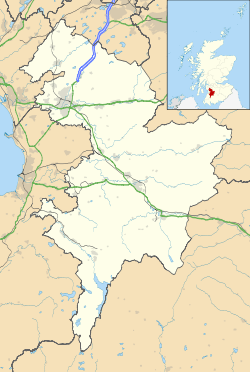Lands of Cockilbie
| Lands of Cocklebie | |
 Lands of Cocklebie |
|
| Council area | East Ayrshire |
|---|---|
| Lieutenancy area | Ayrshire |
| Country | Scotland |
| Sovereign state | United Kingdom |
| Post town | Kilmarnock |
| Police | Scottish |
| Fire | Scottish |
| Ambulance | Scottish |
| EU Parliament | Scotland |
Coordinates: 55°40′59″N 4°31′05″W / 55.683°N 4.518°W
The Lands of Cocklebie or Cocklebee formed an estate possessing a common border with the estates of Lainshaw, the Corsehill, and the town of Stewarton, East Ayrshire, Parish of Stewarton, Scotland.
History
The house and estate
The 40 shilling lands of Cocklebie with "manour place, towers, biggings, and yards, in the Barony of Stewarton, Bailiary of Cunninghame, with teinds, parsonage, and vicarage of Cocklebie."[1] Cocklebie Meadow recorded.[2] The farm of Cocklebie was part of the Lainshaw Estate in 1873.[3] Cocklebierigg[4] and Cocklebie croft are also recorded.[5]
Lairds
In 1476 David Lindsay and his wife, former wife of Jenkin Stewart, were in dispute with John Ross of Montgreenan over the tack of three merks worth of the lands of Cockilbie.[6]
In 1608 Robert Montgomerie of Kirklands held the sasine of the lands of Cockilbie. In 1630 John Montgomerie of Cockilbie was nominated by the Lord Commissioners as a sub-commissioner at the Presbytery of Irvine for valuing the teinds (tithes) of Scotland in that area.[7]
In 1638, John Montgomerie of Cockilbie died, leaving a wife, Jeanne Forrester and children John, Agnes, Barabara, Margaret, and Catherine. He may have held Broadstone Castle near Beith and held lands in Ireland. The will was signed at Cockilbee in 1636.
The Hon Alexander Cunningham of Corsehill (d. May 1646), married Marion Porterfield, the daughter of William Porterfield of that Ilk and Duchal, and had a child, Sir Alexander Cunningham of Corsehill. Alexander married Mary Stewart, daughter of John Stewart of Blackhall, and had two children, the second of whom was known as Cuthbert Cunningham of Cockilbie.[8]
Neil Montgomerie married the heiress of Lord Lyle and had a son, Neil, who died before 1621. Their son, Neil, had married Elizabeth, daughter of John Cunningham and had four children, Neil of Lainshaw, William of Bridgend, James of Dunlop, and John of Cockilbie. Neil and his son John sold their estates in 1654 to John of Cockilbie.[9]
In 1666 Cuthbert Cunynghame of Cocklebee (sic) disponed the lands of Cockilbee and Kirktowne to Alexander Cunynghame younger of Corshill, giving up the rental of the lands.[10]
The holder of the lands of Cockilbie had the 'right and privilege' of holding a weekly market and four yearly fairs.[11]
Cartographic evidence
The 1779 Lainshaw and Kirkwood Estate map shows East (with parks and yards) and West Cockilbie, amounting to 7 Acres for East and 77 for West. An un-named group of three houses are shown on the Dunlop road with the yard and a well opposite.[12] Roy's map shows 'Cocklebay' as the placename spelling.[13]
John Thomson's map of 1832 records the site as 'Cockle'.
The 1856 25" mile OS map shows a 'Cocklebee' with a sandstone quarry of that name nearby.

Micro-history
The word 'cockle' in Scots refers to a fir cone and is a common name for various weeds. The term 'bie' means a settlement as in Whitby.
Cocklebie Road and Cockilbee View in Stewarton commemorate the location of the old farm and manor house.
Alexander Dickie and John Wyllie are recorded as the tenants of Cocklebee (sic) in 1666.[14]
In 1668 the baron-court of Corshill determined that all the graine groundable from the lands of Cocklbee and Kirktowne (sic) should be ground at Clerkland Mill.[15]
In 1671 James Limont pursued Robert Wilson of Cockilbie at the barony court for withholding 8 merks of payment to Issobel Lymont (sic).[16]
In 1673 the baillie of the barony court instructed William Smith of Cockilbie to pay Robert Smith of Kirkton the sum of six pounds and five shillings.[17]
In 1679 Alexander Dickie of Cocklebee pursued John Pinkerton in Goosehills for corn that had been eaten by his animals and that had not been paid for.[18]
In 1683 Allan Greer, a skinner from Kilmarnock, pursued Alexander Dickie for £17 Scots.[19]
In 1687 John Wyllie of Cocklbee promised to ensure that his brother-german, Andrew Wyllie, would act in a christian and peaceful fashion.[20]
See also
References
- Notes
- ↑ Lainshaw, Page 2
- ↑ Lainshaw, Page 3
- ↑ Lainshaw,Page 90
- ↑ Lainshaw, Page 233
- ↑ Lainshaw, Page 368
- ↑ Dobie, Page 333
- ↑ Dobie, Page 37
- ↑ Croft's Peerage Retrieved : 2012-01-12
- ↑ Montgomery, Pages 19 - 20
- ↑ Arch & Hist Ayrs & Wigton, Page 71
- ↑ Search over Lainshaw, Page 252
- ↑ Crawfurd
- ↑ Roy's Map
- ↑ Arch & Hist Ayr & Wigton. Page 69
- ↑ Arch & Hist Ayr & Wigton. Page 81
- ↑ Arch & Hist Ayr & Wigton. Page 99
- ↑ Arch & Hist Ayr & Wigton. Page 110
- ↑ Arch & Hist Ayr & Wigton. Page 155
- ↑ Arch & Hist Ayr & Wigton. Page 164
- ↑ Arch & Hist Ayr & Wigton. Page 174
- Sources
- Archaeological and Historical Collections relating to the counties of Ayr & Wigton. 1884. v. iv.
- Dobie, James D. (ed Dobie, J.S.) (1876). Cunninghame, Topographized by Timothy Pont 1604–1608, with continuations and illustrative notices. Glasgow: John Tweed.
- Crawford, William (1779). Plan of the Estates of Lainshaw and Kirkwood.
- Montgomery, D. B. (1903). The Montgomerys and their Descendents. Owensville : J. P. Cox.
- Search over Lainshaw Register of Sasines.